Evaluation of Rheological Properties of Warm Mix Flame-Retardant Asphalt (WMFRA) Binder Suitable for Tunnel Area
Abstract
1. Introduction
2. Materials and Methods
2.1. Raw Materials
2.2. Sample Preparation
2.3. Characterization
2.3.1. Conventional Performance Test
2.3.2. High Temperature Rheological Test
2.3.3. Low Temperature Rheological Test
2.3.4. Fatigue Test
2.3.5. Oxygen Index Test
3. Results and Discussion
3.1. Conventional Properties
3.2. Oxygen Index Properties
3.3. High Temperature Rheological Properties
3.4. Low Temperature Rheological Properties
3.5. Fatigue Properties
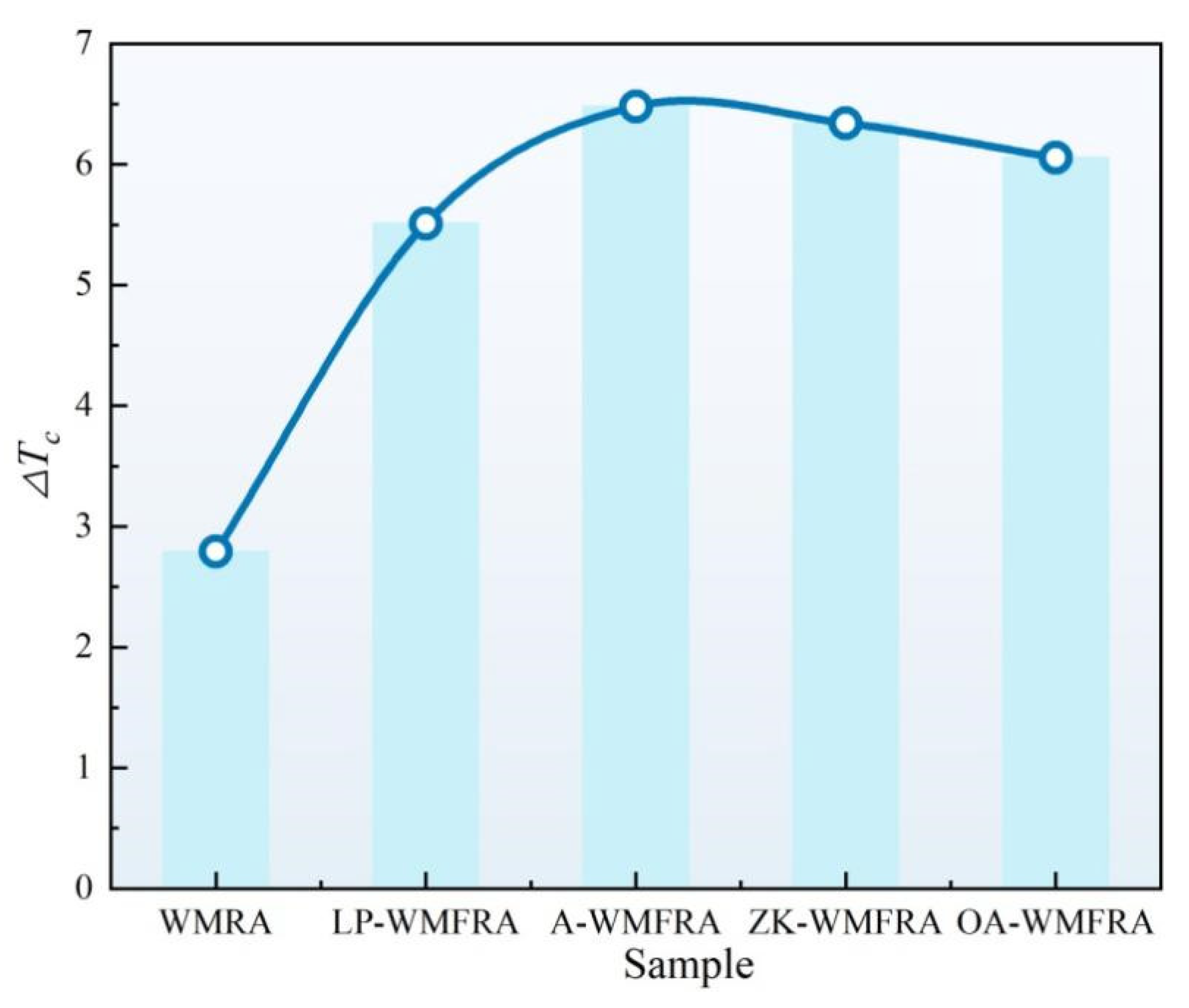
| Sample | Nf50 (s) |
|---|---|
| WMRA | 2765.4 |
| LP-WMFRA | 1806.5 |
| ZK-WMFRA | 2857.2 |
| A-WMFRA | 2095.7 |
| OA-WMFRA | 2790.5 |
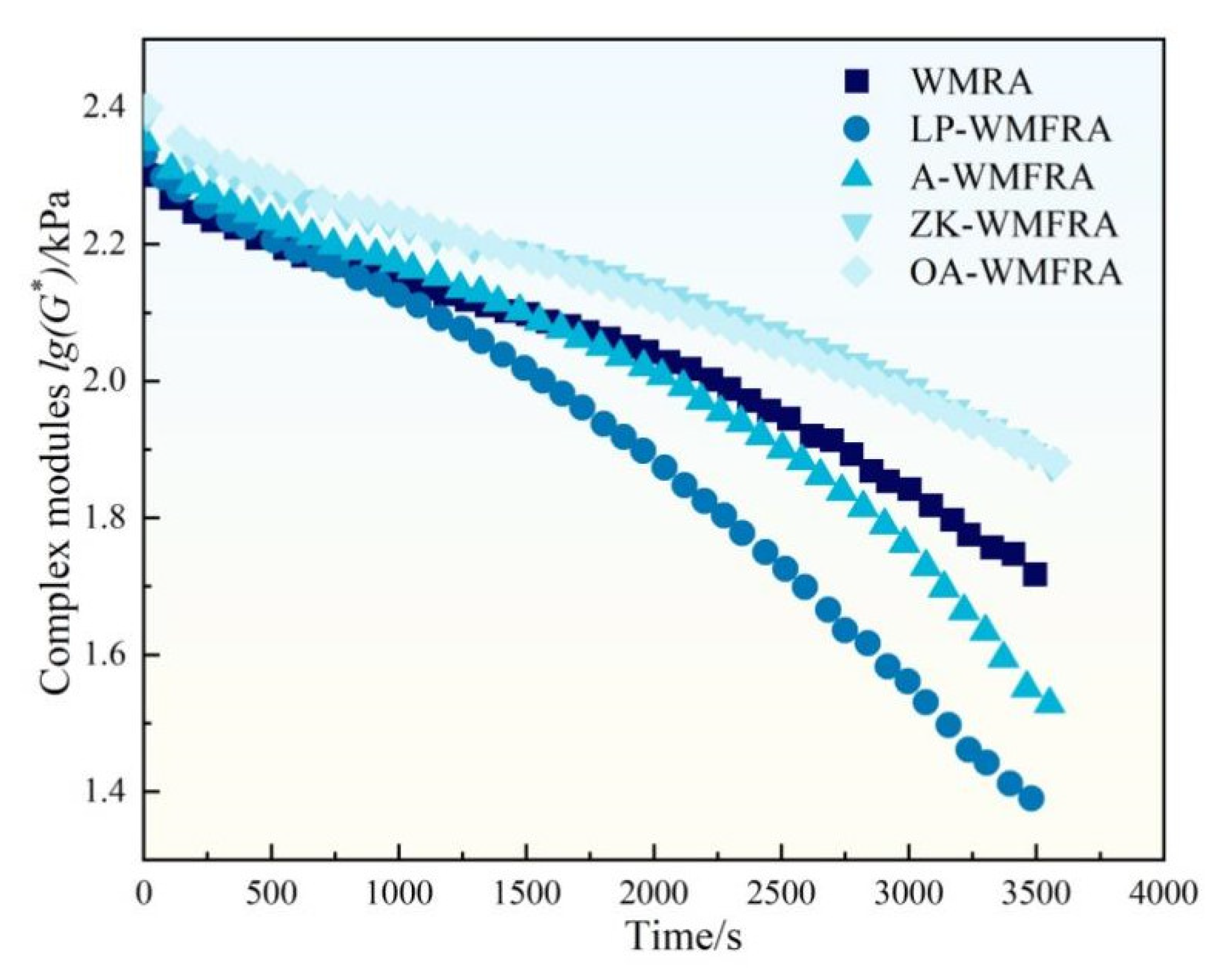
4. Conclusions
- (1)
- The S-type warm mix agent significantly improved the fluidity of asphalt by reducing its viscosity by 46.7% at 135 °C but slightly reduced the low-temperature cracking resistance. However, R-type warm mix agent had the ability to enhance the low-temperature performance of asphalt but decreased the high-temperature stability, and the viscosity was reduced by a relatively small amount of 15.1% at 135 °C.
- (2)
- The OA flame retardant composed of aluminum hydroxide (ATH) and organic modified montmorillonite (OMMT) had the best flame-retardant effect on WMFRA, and when OA dosage reached 15%, due to the synergistic effect of ATH’s heat absorption and water release and OMMT’s oxygen-blocking effect, the oxygen index was increased to 24%, which was significantly more than the application requirement of 23%.
- (3)
- The OA flame retardant improved the high-temperature performance of WMFRA most significantly, with its complex modulus and rutting factor significantly higher than those of other WMFRAS. In addition, the incorporation of flame retardants generally reduced the temperature sensitivity of WMFRA, with the ZK flame retardant showing the most prominent improvement in temperature sensitivity by 12.6%.
- (4)
- LP (limestone power) and ATH could enhance the stress relaxation of WMFRA, whereas ZK (zinc borate) and OA could be detrimental to the low-temperature performance of WMFRA, and all flame retardants would lead to a decrease in the low-temperature flexibility of WMFRA to some extent. According to the results of ΔTc, the low-temperature behavior of all WMFRAs was mainly controlled by S(t).
- (5)
- LP and ATH dramatically lowered the fatigue life of WMFRA, with Nf50 reduced to 958.9 s and 669.7 s, respectively, while ZK improved fatigue life by 3.2% through the formation of a cross-linked structure. The Nf50 of OA-WMFRA was comparable to that of WMRA, but its complex modulus declined more slowly, suggesting that the flame retardant may have inhibited deformation of the asphalt while increasing rigidity recovery ability.
Author Contributions
Funding
Institutional Review Board Statement
Data Availability Statement
Conflicts of Interest
References
- Azadgoleh, M.A.; Mohammadi, M.M.; Ghodrati, A.; Sharifi, S.S.; Palizban, S.M.M.; Ahmadi, A.; Vahidi, E.; Ayar, P. Characterization of contaminant leaching from asphalt pavements: A critical review of measurement methods, reclaimed asphalt pavement, porous asphalt, and waste-modified asphalt mixtures. Water Res. 2022, 219, 118584. [Google Scholar] [CrossRef]
- Jiang, X.; Zhu, H.H.; Yan, Z.G.; Zhang, F.S.; Huang, X.Y.; Leng, Z.; Yan, C.Q.; Hua, N.; Lu, D.; Zhang, X.H.; et al. Fire-retarding asphalt pavement for urban road tunnels: A state-of-the-art review and beyond. Fire Technol. 2024, 61, 2737–2777. [Google Scholar] [CrossRef]
- Leng, C.; Lu, G.Y.; Gao, J.L.; Liu, P.F.; Xie, X.G.; Wang, D.W. Sustainable green pavement using bio-based polyurethane binder in tunnel. Materials 2019, 12, 1990. [Google Scholar] [CrossRef] [PubMed]
- Feng, S.Z.; Kan, D.Y.; Zhou, L.; Liu, X.L.; Du, C.Y.; Mao, W.X. Experimental study on effect of pavement background on obstacle visibility in LED lighting environment of road tunnel. Undergr. Space 2025, 22, 124–136. [Google Scholar] [CrossRef]
- Song, K.P.; Pan, Y.T.; Zhang, J.; Song, P.A.; He, J.Y.; Wang, D.Y.; Yang, R.J. Metal–organic frameworks–based flame-retardant system for epoxy resin: A review and prospect. Chem. Eng. J. 2023, 468, 143653. [Google Scholar] [CrossRef]
- Patel, R.; Chaudhary, M.L.; Patel, Y.N.; Chaudhari, K.; Gupta, R.K. Fire-Resistant Coatings: Advances in Flame-Retardant Technologies, Sustainable Approaches, and Industrial Implementation. Polymers 2025, 17, 1814. [Google Scholar] [CrossRef]
- Xiao, F.P.; Guo, R.; Wang, J.G. Flame retardant and its influence on the performance of asphalt—A review. Constr. Build. Mater. 2019, 212, 841–861. [Google Scholar] [CrossRef]
- Qiu, J.L.; Yang, T.; Wang, X.L.; Wang, L.X.; Zhang, G.L. Review of the flame retardancy on highway tunnel asphalt pavement. Constr. Build. Mater. 2019, 195, 468–482. [Google Scholar] [CrossRef]
- Liu, H.; Zhang, Z.P.; Wang, Z.F.; Sun, J.; Wei, Y.M.; Zhang, D.L. Preparation and properties of flame-retardant asphalt containing polyurethane and eco-friendly flame retardants. Constr. Build. Mater. 2023, 375, 130996. [Google Scholar] [CrossRef]
- Tian, B.; Li, R.; Wang, D. Preparation of flame-retardant asphalt for tunnels. Adv. Mater. Res. 2012, 391–392, 189–194. [Google Scholar]
- Li, W.B.; Zheng, M.L.; Zhang, L.W.; Peng, P.; Yang, J.P. Development and performance evaluation of composite flame retardant based on the thermodynamic properties of asphalt components. Constr. Build. Mater. 2024, 455, 139152. [Google Scholar] [CrossRef]
- Tan, Y.W.; Xie, J.G.; Wang, Z.Q.; Li, K.; He, Z.Y. Effect of halloysite nanotubes (HNTs) and organic montmorillonite (OMMT) on the performance and mechanism of flame retardant-modified asphalt. J. Nanoparticle Res. 2023, 25, 74. [Google Scholar] [CrossRef]
- Yang, M.; Yuan, B.H. Modification of Aluminum Hydroxide by Ball Milling: A Feasible Method to Obtain High-Efficiency Flame Retardants for Production of High-Performance EVA Composites. Materials 2025, 18, 984. [Google Scholar] [CrossRef]
- Liu, C.; Zong, R.W.; Chen, H.Y.; Wang, J.L.; Wu, C.P. Comparative study of toxicity for thermoplastic polyurethane and its flame-retardant composites. J. Thermoplast. Compos. Mater. 2019, 32, 1393–1407. [Google Scholar] [CrossRef]
- Wang, Z.; Feng, Z.G.; Cai, F.J.; Zheng, K.X.; Li, X.J. Flame retardancy and rheological properties of warm-mix rubber asphalt binder containing various flame retardants. J. Mater. Civ. Eng. 2024, 36, 04024275. [Google Scholar] [CrossRef]
- Pan, R. Fatigue Performance Evaluation of Warm-Mixed Rubber Asphalt Mixture for Stress Absorption Layer in Cold Area. Buildings 2024, 14, 3817. [Google Scholar] [CrossRef]
- Choudhary, R.; Julaganti, A.; Kumar, A.; Ugale, D.A. Application of WMA technology to bituminous base course mixes. Balt. J. Road Bridge Eng. 2018, 13, 94–103. [Google Scholar] [CrossRef]
- Gong, C.H.; Jiang, J.W.; Liu, T.C.; Zhang, R.H.; Xu, D. Compaction optimization of surfactant-tailored basalt-fiber WMA by improved lubrication and micro-structure formation. Constr. Build. Mater. 2025, 484, 141905. [Google Scholar] [CrossRef]
- Topal, A.; Sengoz, B.; Kok, B.V.; Yilmaz, M.; Dokandari, P.A.; Oner, J.; Kaya, D. Evaluation of mixture characteristics of warm mix asphalt involving natural and synthetic zeolite additives. Constr. Build. Mater. 2014, 57, 38–44. [Google Scholar] [CrossRef]
- Aljbouri, R.Q.; Albayati, A.H. Investigating the effect of nanomaterials on the Marshall properties and durability of warm mix asphalt. Cogent Eng. 2023, 10, 2269640. [Google Scholar] [CrossRef]
- Han, Y.F.; Duan, P.P.; Yu, F.; Yang, A.Y.; Zeng, S.H.; Chen, P.P.; Xu, Y.; Nie, W.Y.; Min, Z.H.; Zhou, Y.F. Tuning high-and low-temperature rheological properties of warm-mixing asphalt composites by functionalized waxes. Mater. Today Commun. 2024, 39, 109094. [Google Scholar] [CrossRef]
- Gao, Z.W.; Fu, H.; Chen, Q.; Cao, Y.S. Rheological properties and viscosity reduction mechanism of SBS warm-mix modified asphalt. Pet. Sci. Technol. 2020, 38, 556–564. [Google Scholar] [CrossRef]
- Dong, F.Q.; Yu, X.; Liang, X.M.; Liu, S.J.; Ding, G.Y.; Xu, B. The Influence of Foaming Water Content on the Aging Characteristic of Foamed Warm-Mix Asphalt. In Proceedings of the Transportation Research Congress 2016: Innovations in Transportation Research Infrastructure, Beijing, China, 6–8 June 2018; pp. 98–105. [Google Scholar]
- Huang, X.Y.; Ban, Y.Y.; Du, L.; Wang, L. Molecular-Scale Study of the Compatibility of Warm-Mix Agents, Rubber, and Asphalt in Warm-Mix Rubber Asphalt. J. Mater. Civ. Eng. 2025, 37, 04025260. [Google Scholar] [CrossRef]
- Chen, B.; Dong, F.Q.; Yu, X.; Ren, S.S.; Zheng, C.J. Chemo-rheological characterization of aging behaviors of warm-mix high-viscosity modified asphalt. J. Mater. Civ. Eng. 2022, 34, 04022342. [Google Scholar] [CrossRef]
- Tong, B.; Song, X.Y.; Shen, J.A.; Jiang, T.; Chen, J.F.; Niu, J.F. Effect of Sasobit warm mix on micro properties of asphalt with different degrees of regeneration. Front. Mater. 2022, 9, 950550. [Google Scholar] [CrossRef]
- Zhang, J.Z.; Li, P.Z.; Sun, C.J.; Liang, M.; Li, Y.Y.; Yao, Z.Y.; Zhang, X.M. Effects of composite warm mix additive (CAR) on the physical and rheological performance of bitumen and the pavement performance of its concrete. Materials 2019, 12, 3916. [Google Scholar] [CrossRef] [PubMed]
- Wang, J.J.; Li, H.Q.; Chen, X.G.; Peng, C. Influence of different types of warm mix agents on the viscosity reduction effect of Karamay modified asphalt. China Highw. 2025, 96–99. [Google Scholar] [CrossRef]
- Qin, W.; Yang, J.Z.; Ma, F.; Yang, Y.F. Research on the preparation and performance of warm-mixed high-viscosity modified asphalt in alpine region. Appl. Chem. Eng. 2025, 54, 624–629. [Google Scholar] [CrossRef]
- Tang, N.; Wang, H.Y.; Fu, D.; Wu, L.F.; Wang, Q. Research progress on warm mixing technology of asphalt mixture. China Mater. Prog. 2020, 39, 653–660. [Google Scholar] [CrossRef]
- He, L.; He, Z.Y.; Ling, T.Q.; Ma, T.; Huang, X.M. Research on construction workability of asphalt-rubber mixture with warm mix additives. Funct. Mater. 2015, 46, 20102–20107. [Google Scholar]
- He, S. Research on the Application of Warm Mixing Technology for Modified Asphalt Pavement in Expressway Tunnels. Master’s Thesis, Chang’an University, Xi’an, China, 2021. [Google Scholar]
- Wu, B. Research on the Flame Retardant System and Road Performance of Composite Hydroxide Asphalt. Master’s Thesis, Zhejiang University, Hangzhou, China, 2015. [Google Scholar]
- Wu, H.S.; Shen, A.Q.; He, Z.M.; Deng, S.Y.; Wang, K.; Li, Y. Mechanism of a warm-mix agent and its effects on the rheological properties and thermal stability of aluminum hydroxide and organic montmorillonite composite flame-retardant asphalt. J. Mater. Civ. Eng. 2023, 35, 04023058. [Google Scholar] [CrossRef]
- Liu, S.J.; Wang, H.M.; Zeng, L.H.; Jiao, X.D. Rheological Properties and Micromechanism of Warm-Mix Flame-Retardant Asphalt. J. Mater. Civ. Eng. 2024, 36, 04024248. [Google Scholar] [CrossRef]
- Xu, F.; Li Zy Liu, Y.Z.; Xie, H.J.; Long, Z.W.; Dai, B.T.; Yang, H.; Zhu, C.Z.; You, L.Y.; Jin, D.Z. Microscopic morphology and adhesion performance of SBS/OMMT modified asphalt under chloride salt erosion. Constr. Build. Mater. 2025, 458, 139578. [Google Scholar] [CrossRef]
- Ghasemirad, A.; Bala, N.; Hashemian, L. High-temperature performance evaluation of asphaltenes-modified asphalt binders. Molecules 2020, 25, 3326. [Google Scholar] [CrossRef]
- Zhang, X.R.; Han, C.; Yang, J.; Xu, X.Q.; Zhang, F. Evaluating the rheological properties of high-modulus asphalt binders modified with rubber polymer composite modifier. Materials 2021, 14, 7727. [Google Scholar] [CrossRef]
- Wang, T.; Jiang, W.; Ruan, C.; Xiao, J.J.; Yuan, D.D.; Wu, W.J.; Xing, C.W. The rheological properties of high-viscosity modified reclaimed asphalt binder at multiple application temperatures. Constr. Build. Mater. 2023, 372, 130758. [Google Scholar] [CrossRef]
- Niu, Y.H.; Wang, X.Y.; Burmistrov, I.; Niu, D.Y. Rheological properties and 3D printability of SBS/CR-modified asphalt binder with C9 petroleum resin for crack filling. Front. Mater. 2024, 11, 1416246. [Google Scholar] [CrossRef]
- Jia, M.; Zhang, Z.P.; Liu, H.T.; Peng, B.; Zhang, H.L.; Lv, W.J.; Zhang, Q.; Mao, Z.Y. The synergistic effect of organic montmorillonite and thermoplastic polyurethane on properties of asphalt binder. Constr. Build. Mater. 2019, 229, 116867. [Google Scholar] [CrossRef]
- Mirzaiyan, D.; Ameri, M.; Amini, A.; Sabouri, M.; Norouzi, A. Evaluation of the performance and temperature susceptibility of gilsonite-and SBS-modified asphalt binders. Constr. Build. Mater. 2019, 207, 679–692. [Google Scholar] [CrossRef]
- Arshadi, M.; Taherkhani, H. Investigating the properties of asphalt binder modified by high-and low-density polyethylene polymer and nano-silica. Road Mater. Pavement Des. 2024, 25, 838–859. [Google Scholar] [CrossRef]
- Sun, M.K.; Guo, Q.; He, Z.Y.; Yuan, L.; Sun, D.X.; Fang, K.; Wei, D.B. Multi-objective optimization and performance investigation of surface modification synergistic warm-mixed flame retardant asphalt. Constr. Build. Mater. 2025, 473, 141021. [Google Scholar] [CrossRef]
- Chen, X.B.; Wang, J.T.; Zhang, X.R.; Liu, H.; Tong, J.H.; Zhao, R.L. Evaluating the Physical and Rheological Properties of Rejuvenated Styrene-Butadiene-Styrene-Modified Asphalt Binders. Adv. Mater. Sci. Eng. 2020, 2020, 4513824. [Google Scholar] [CrossRef]
- Ma, F.; Zhu, C.X.; Fu, Z.; Li, C.; Hou, Y.J.; Jiang, X.Y.; Wu, M. Analysis of rheological behavior and anti-aging properties of SBS modified asphalt incorporating UV absorbent and naphthenic oil (NPO). Constr. Build. Mater. 2023, 377, 130958. [Google Scholar] [CrossRef]
- Li, X.; Gibson, N.; Andriescu, A.; Arnold, T.S. Performance evaluation of REOB-modified asphalt binders and mixtures. Road Mater. Pavement Des. 2017, 18, 128–153. [Google Scholar] [CrossRef]
- Zhang, Z.; Han, S.; Guo, H.C.; Han, X.; Wu, C. Fatigue performance evaluation of recycled asphalt fine aggregate matrix based on dynamic shear rheometer test. Constr. Build. Mater. 2021, 300, 124025. [Google Scholar] [CrossRef]
- Xiong, L.; Liu, K.; Kadhim, H.A.; Niu, D.Y.; Gao, Y.M.; Liu, X.Y. Comparative analysis of the fatigue characterisation of natural rock asphalt/SBS composite modified asphalt binders using time sweep test and linear amplitude sweep test. Constr. Build. Mater. 2025, 494, 143315. [Google Scholar] [CrossRef]
- Tang, N.P.; Yu, H.L.; Ren, B.; Li, R.; Yi, X.Y.; Zhu, H.Z. Effect of lanthanum oxide and magnesium hydroxide on flame retardancy, rheological properties, and aging resistance of SBS modified asphalt. Constr. Build. Mater. 2025, 490, 142544. [Google Scholar] [CrossRef]
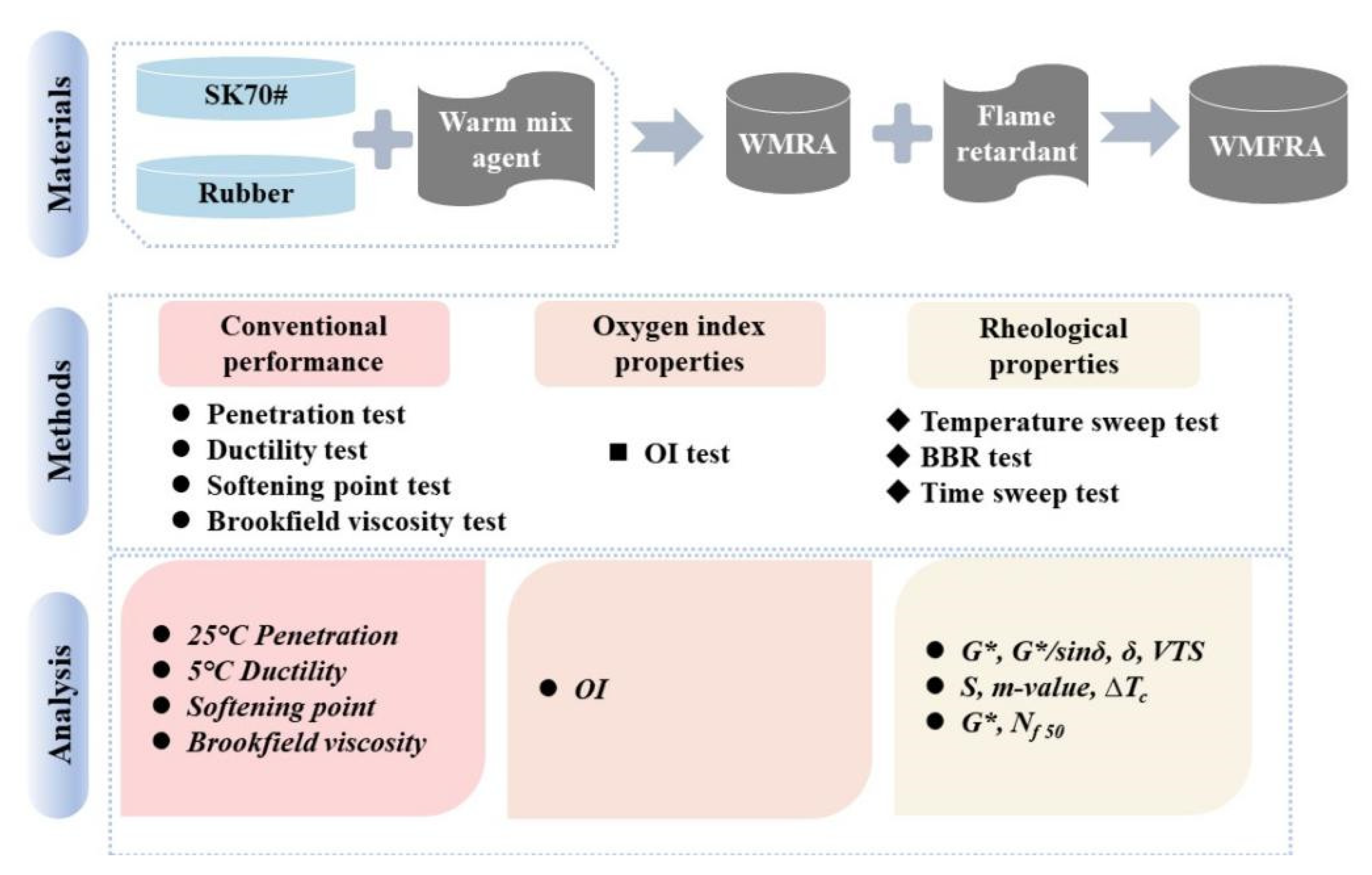
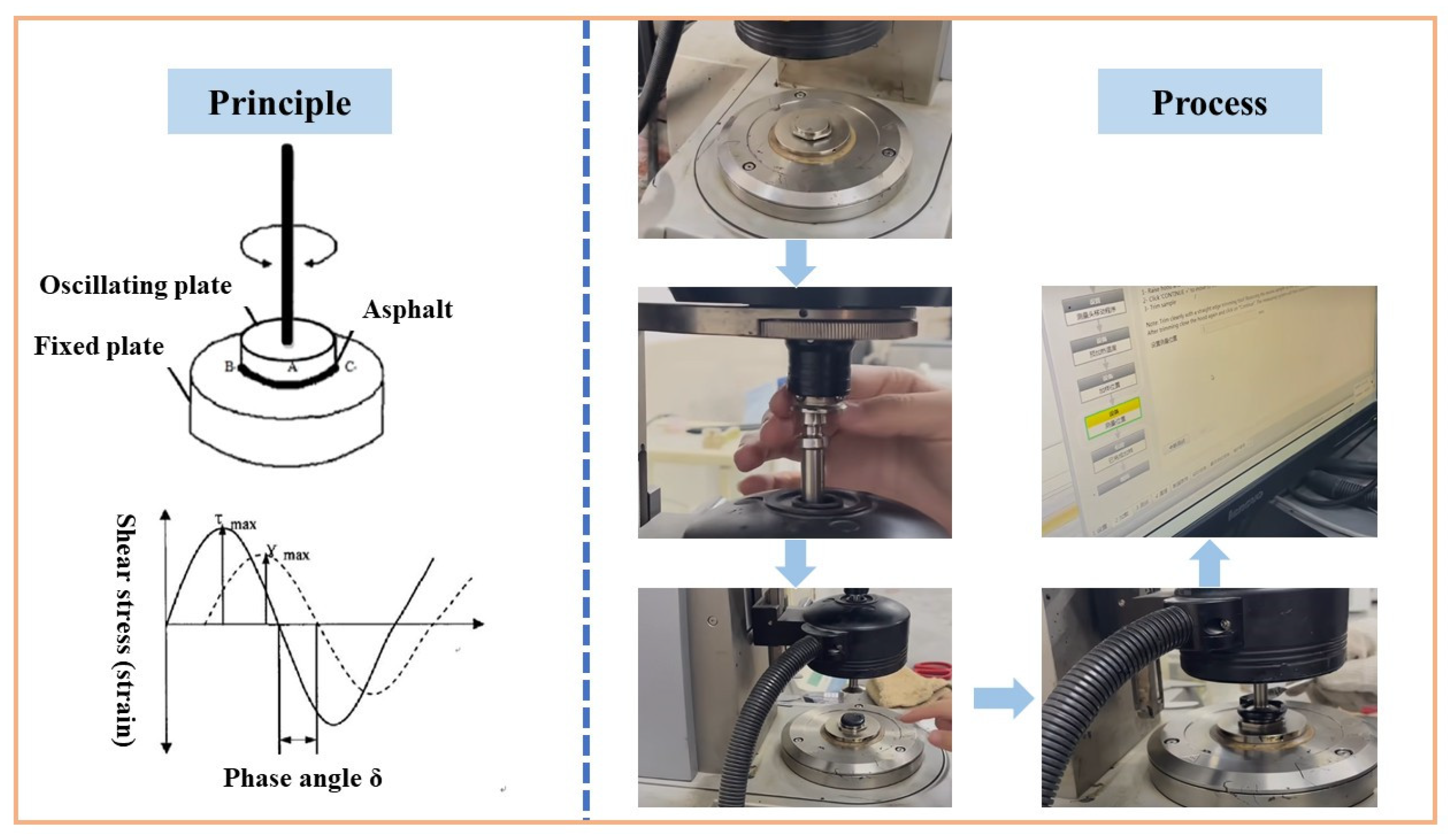
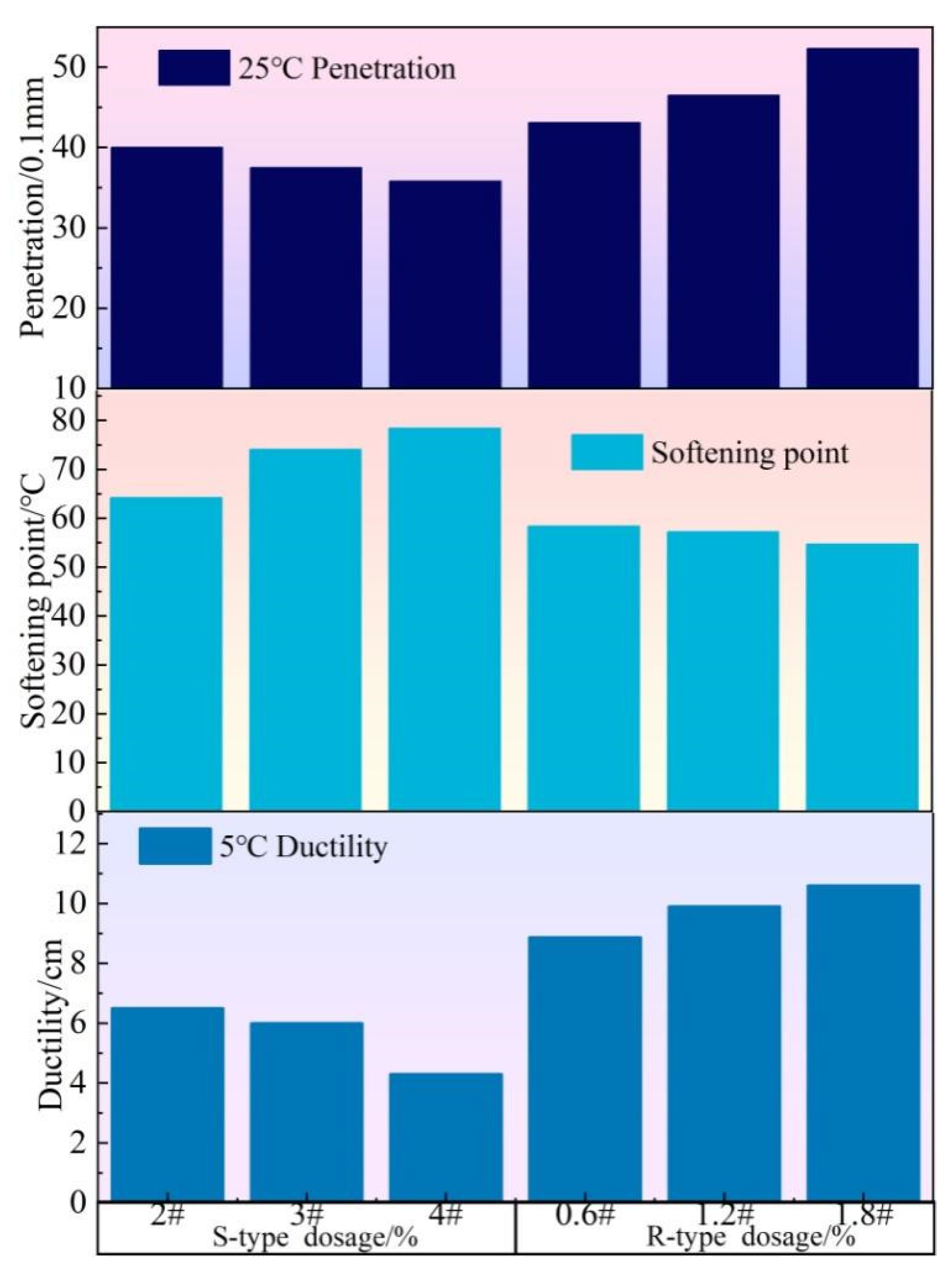
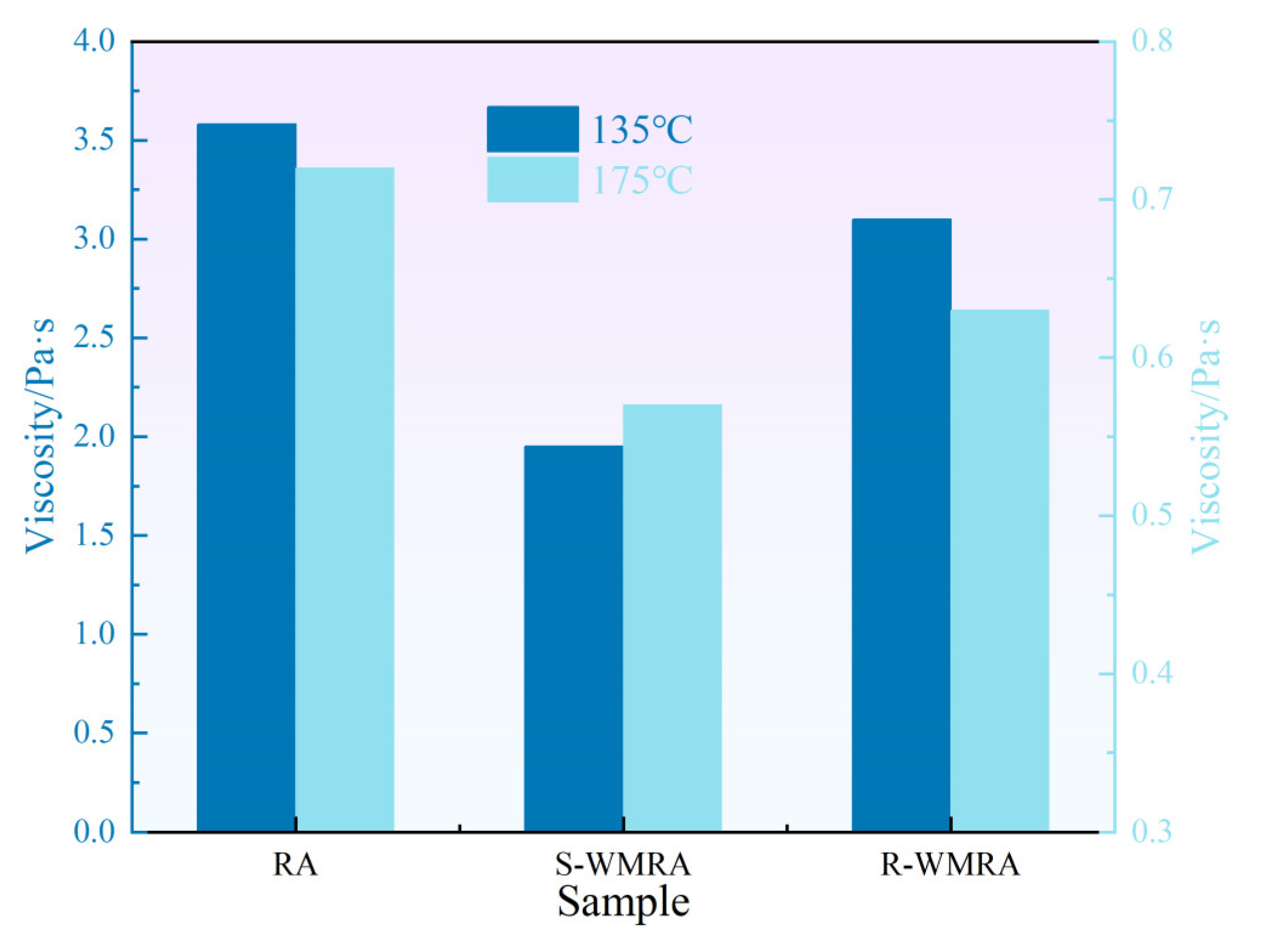
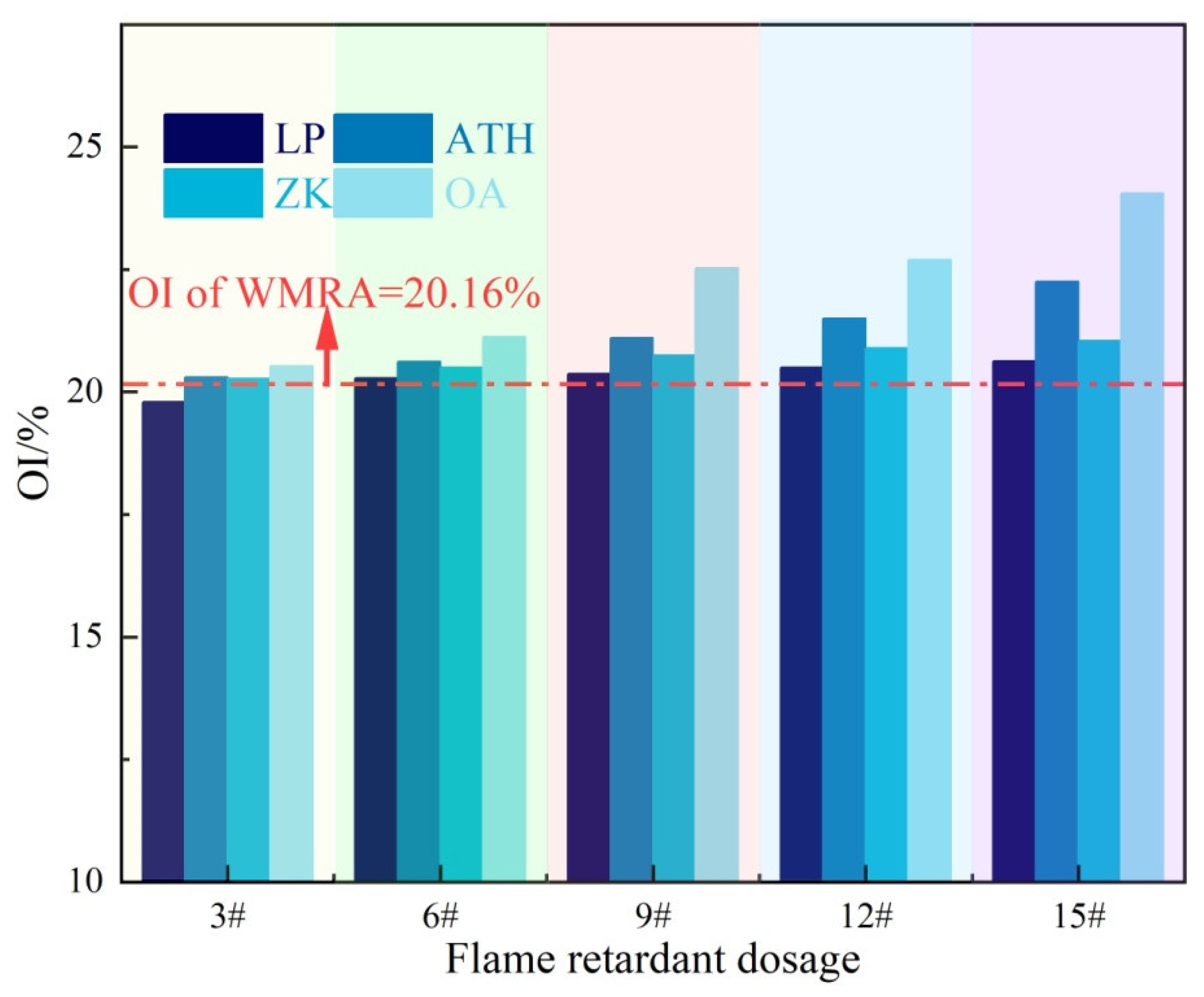
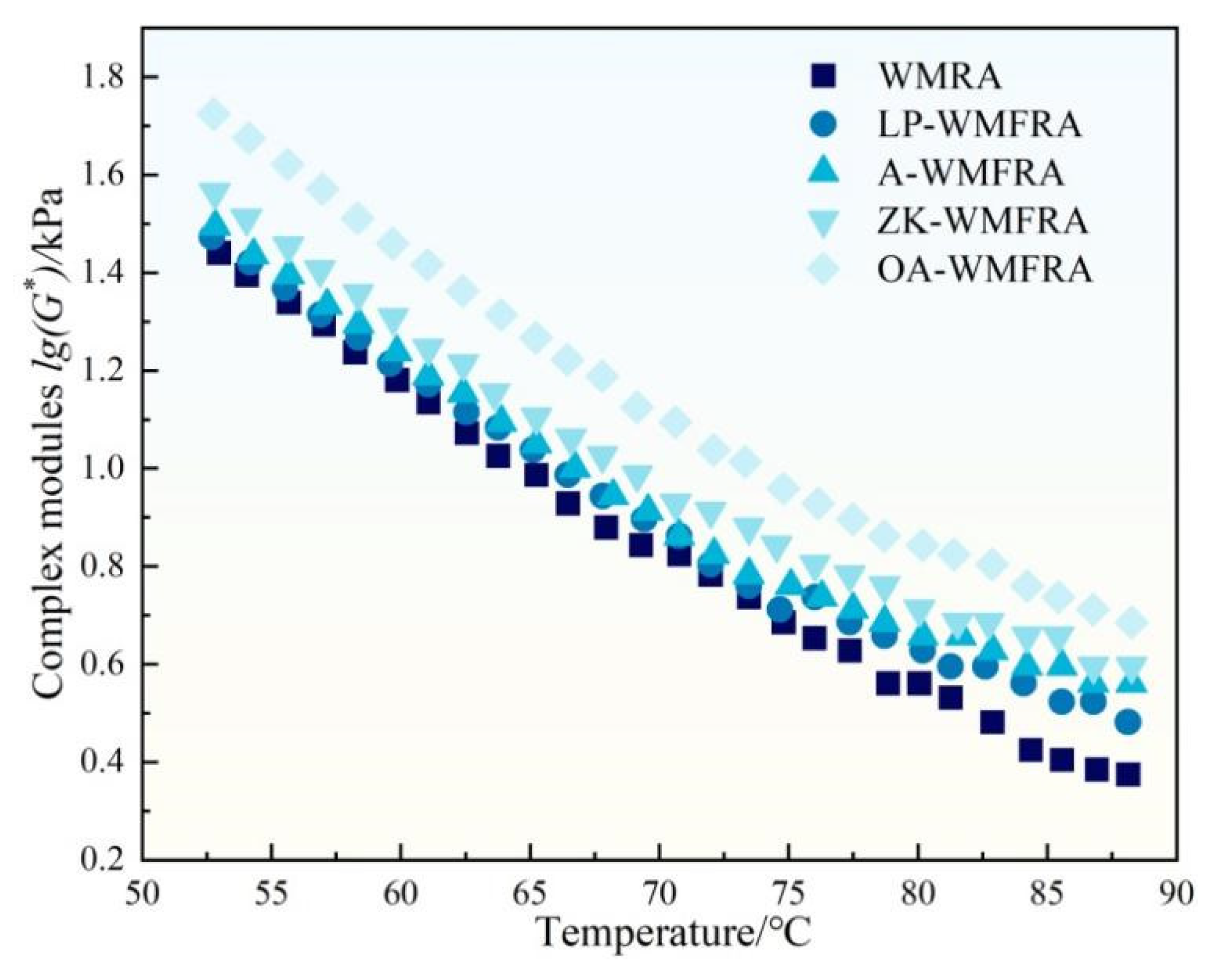

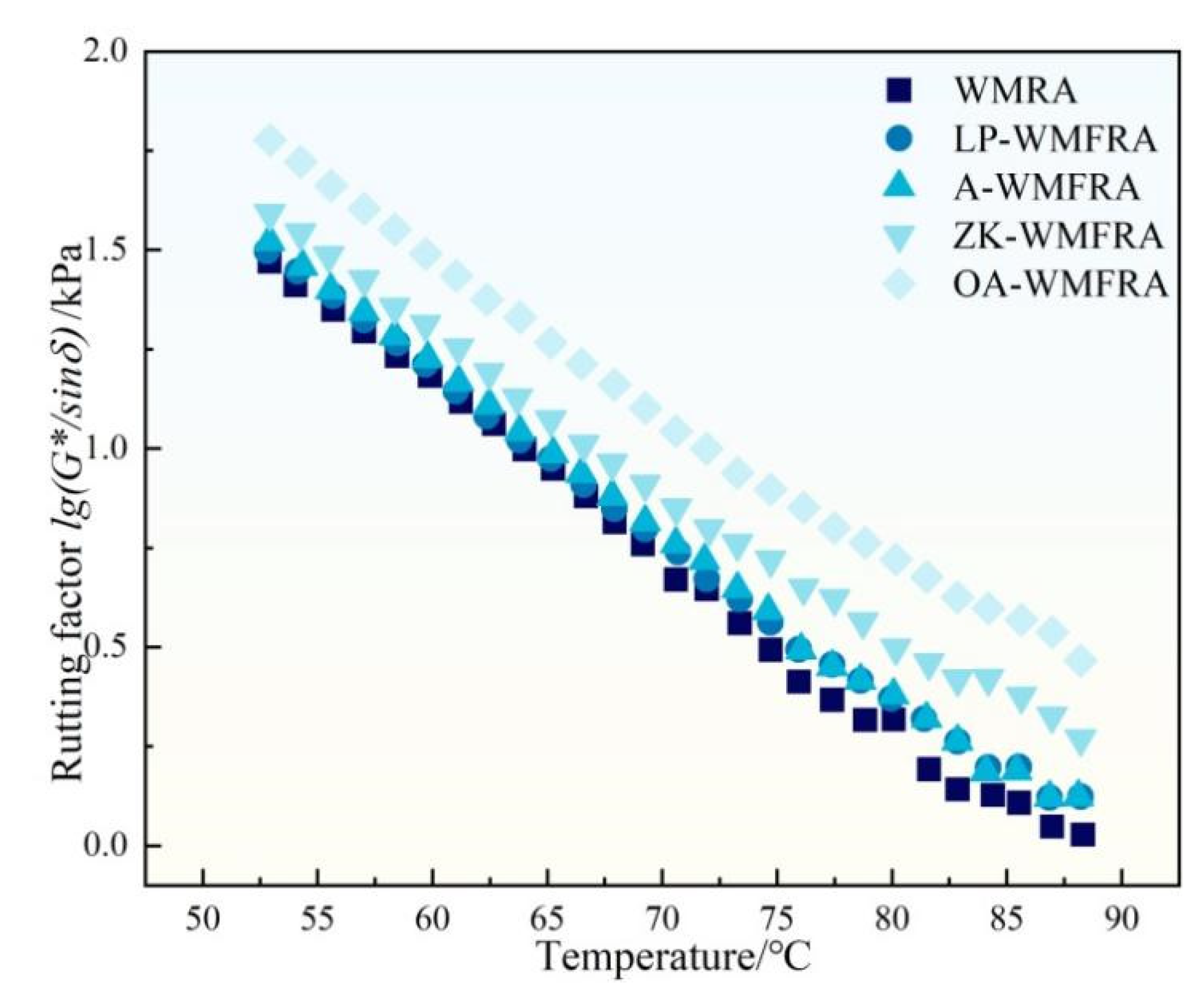
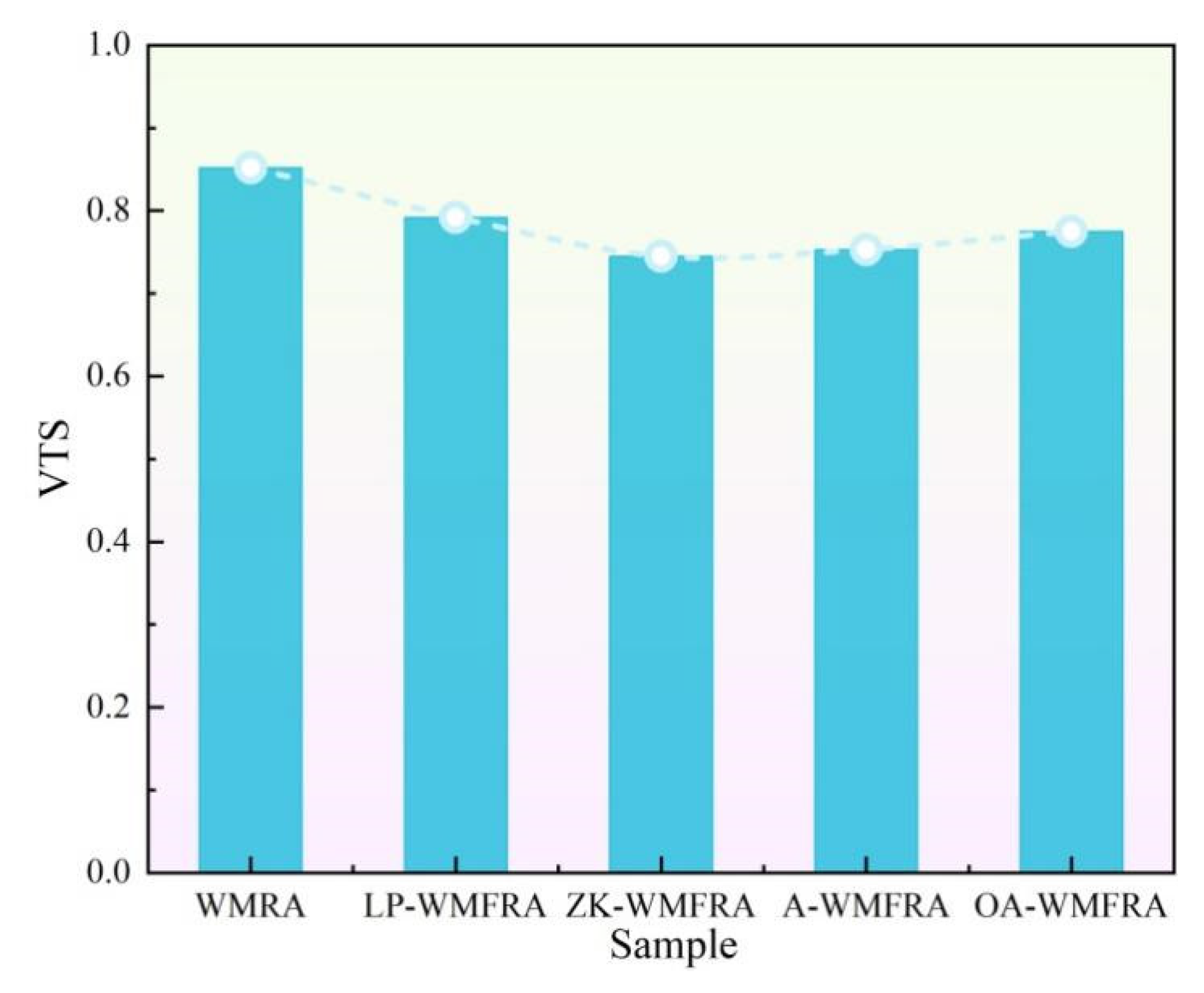

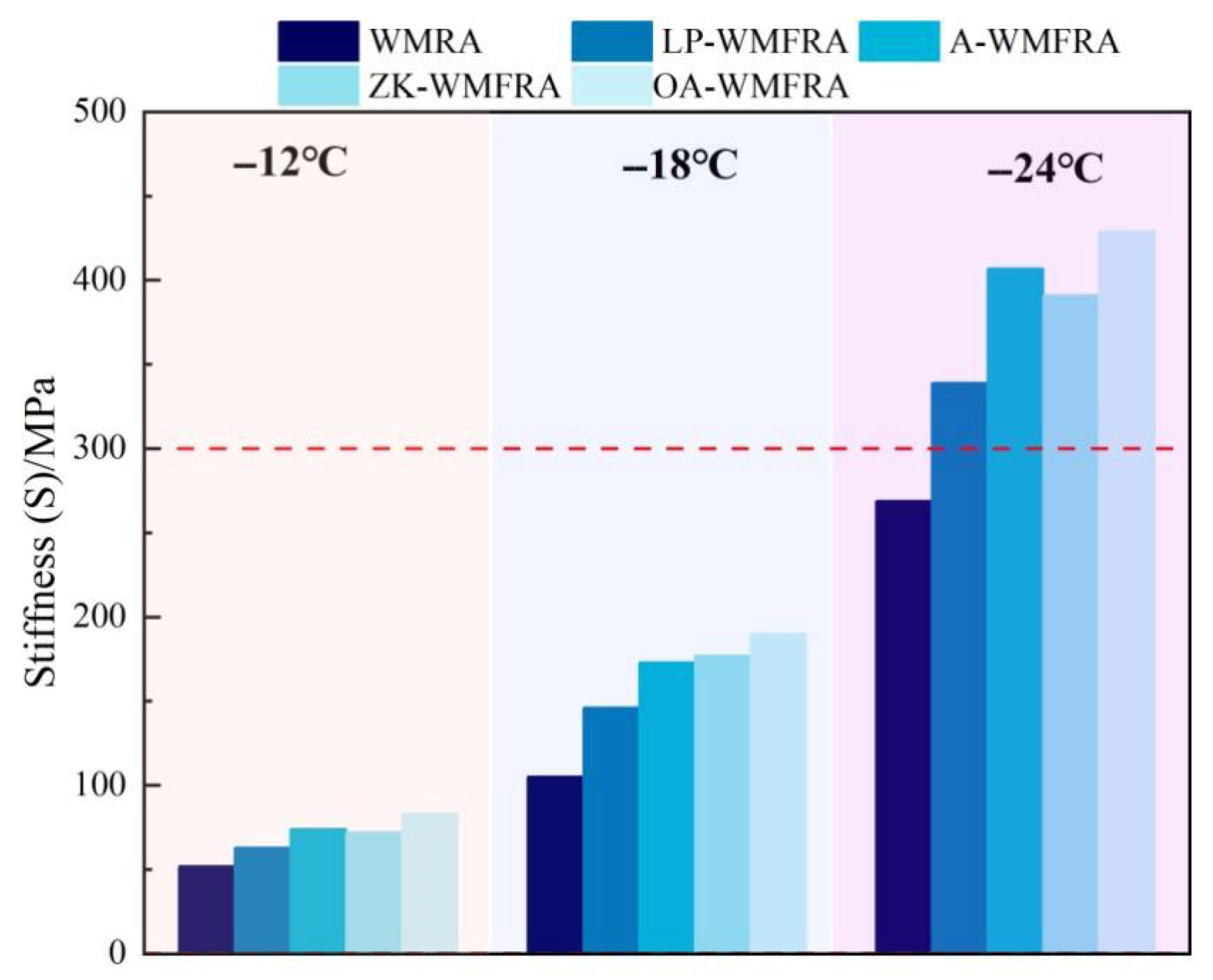
| Item | Index | Measured Value | |
|---|---|---|---|
| 25 °C Penetration (0.1 mm) | 60~80 | 64 | |
| Softening point (°C) | ≮46.0 | 47.5 | |
| 15 °C Ductility (cm) | ≮100 | >100 | |
| Kinetic viscosity 60 °C (Pa·s) | ≮180 | 219 | |
| Flash point (°C) | ≮260 | 282 | |
| Wax content (%) | ≯2.2 | 1.4 | |
| TFOT | Loss of mass (%) | ≯0.8 | 0.03 |
| Penetration ratio (%) | ≮65 | 67.9 | |
| Residual ductility (10 °C, cm) | ≮6.0 | 7.6 | |
| Indicators | Density (25 °C, g/cm3) | Appearances | Melting Point (°C) | Flash Point (°C) |
|---|---|---|---|---|
| Measured value | 0.89 | Solid at normal temperature | >90 | 283 |
| Indicators | Density (25 °C, kg/L) | Appearances | Moisture Content | Flash Point (°C) |
|---|---|---|---|---|
| Measured value | 0.93 | Black green liquid at normal temperature | 0.36 | 230 |
| Item | Index | Measured Value |
|---|---|---|
| Al(OH)3 (%) | ≮99.5 | 99.61 |
| Whiteness (%) | ≮96.5 | 96.7 |
| Al2O3 (%) | ≮64 | 66 |
| SiO2 (%) | ≯0.025 | 0.018 |
| Na2O (%) | ≯0.32 | 0.29 |
| Fe2O3 (%) | ≯0.02 | 0.012 |
| pH | 7.5~8.5 | 7.6 |
| Mean particle size (μm) | 28 ± 0.2 | 28.1 |
| Absorption (mL/20 g) | ≯6.2 | 5.8 |
| Item | Measured Value |
|---|---|
| Content (%) | 95.10 |
| Free water (105 °C, %) | 0.38 |
| Particle size | fine type |
| Apparent color | white gray powder |
| Item | Measured Value |
|---|---|
| Particle size (mesh) | 325 |
| Density (g/cm3) | 1.8 |
| XRD (d001/nm) | 2.7 |
| Ammonia content (%) | 10.8 |
| Item | Index | Measured Value | |
|---|---|---|---|
| Apparent relative density | >2.5 | 2.675 | |
| Particle size range (%) | <0.6 mm | 100 | 100 |
| <0.15 mm | 90~100 | 95.4 | |
| <0.075 mm | 70~100 | 78.7 | |
| Hydrophilicity coefficient | - | 0.75 | |
| Plasticity index (%) | - | 4.3 | |
| Heating stability | - | stable | |
Disclaimer/Publisher’s Note: The statements, opinions and data contained in all publications are solely those of the individual author(s) and contributor(s) and not of MDPI and/or the editor(s). MDPI and/or the editor(s) disclaim responsibility for any injury to people or property resulting from any ideas, methods, instructions or products referred to in the content. |
© 2025 by the authors. Licensee MDPI, Basel, Switzerland. This article is an open access article distributed under the terms and conditions of the Creative Commons Attribution (CC BY) license (https://creativecommons.org/licenses/by/4.0/).
Share and Cite
Zhang, B.; Liu, J.; Le, Q.; Lu, Z. Evaluation of Rheological Properties of Warm Mix Flame-Retardant Asphalt (WMFRA) Binder Suitable for Tunnel Area. Polymers 2025, 17, 2829. https://doi.org/10.3390/polym17212829
Zhang B, Liu J, Le Q, Lu Z. Evaluation of Rheological Properties of Warm Mix Flame-Retardant Asphalt (WMFRA) Binder Suitable for Tunnel Area. Polymers. 2025; 17(21):2829. https://doi.org/10.3390/polym17212829
Chicago/Turabian StyleZhang, Bo, Juan Liu, Qiaoli Le, and Zhen Lu. 2025. "Evaluation of Rheological Properties of Warm Mix Flame-Retardant Asphalt (WMFRA) Binder Suitable for Tunnel Area" Polymers 17, no. 21: 2829. https://doi.org/10.3390/polym17212829
APA StyleZhang, B., Liu, J., Le, Q., & Lu, Z. (2025). Evaluation of Rheological Properties of Warm Mix Flame-Retardant Asphalt (WMFRA) Binder Suitable for Tunnel Area. Polymers, 17(21), 2829. https://doi.org/10.3390/polym17212829




